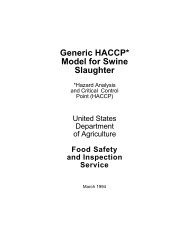Generic HACCP Model for Thermally Processed Commercial
Generic HACCP Model for Thermally Processed Commercial
Generic HACCP Model for Thermally Processed Commercial
Create successful ePaper yourself
Turn your PDF publications into a flip-book with our unique Google optimized e-Paper software.
increase during storage.<br />
Osherhoff, B. J., G. G. Slocum, and W. M. Decker. 1964. Status of Botulism in the United<br />
States. Public Health Reports 79(10):871-878.<br />
From 1899 through 1963, 1,561 cases of botulism were reported in the United States.<br />
The decade of the 1930's had the greatest number of cases followed by the decade of the<br />
1920's and the 1940's. Most of the botulism outbreaks from the 1920's and 1930's to the<br />
mid-1960's could be attributed to home canning, usually improperly or inadequately<br />
processed nonacid foods. From 1906 to 1963, 51 outbreaks involving commercially<br />
prepared foods were reported. Only 5 cases out of 44 from 1950-63 were attributable to<br />
commercial canned product.<br />
Stersky, A., E. Todd, and H. F. Pivnick. 1980. Food poisoning associated with post-process<br />
leakage (PPL) in canned foods. J. Food Prot. 43(6):465-476,483.<br />
154 incidents of food poisoning were associated with post-process leakage (PPL)<br />
between 1921 and 1979. These occurred mainly in UK (72.7%) and Canada (17.5%) from<br />
products exported from South America, Europe, Africa and Australia. Defects leading to<br />
leakage were identified as defective seams and per<strong>for</strong>ations during processing; temporary<br />
microleaks during cooling; and case-cutter damage, punctures, corrosion and dents after<br />
processing. Organisms associated with the incidents were Staphylococcus aureus (100,<br />
64.9%), Salmonella typhi (6, 3.9%) other Salmonella spp. (9, 5.8%), Clostridium<br />
botulinum (3, 2.0%), Clostridium perfringens (3, 2.0%), others and undetermined 33<br />
(21.4%). Canned meat, fish and vegetable products were involved. In particular, corned<br />
beef contaminated with Staphylococcus or Salmonella caused 53 incidents; pork and ham<br />
products contaminated with the same organisms caused 16 incidents. Where in<strong>for</strong>mation<br />
was available, it was found that the median amount of meat contaminated with Salmonella<br />
consumed by ill persons was 105 g. For Salmonella-contaminated fish the amount<br />
associated with illness was 40-320 g. Although many of the PPL incidents recorded<br />
occurred decades ago, significant outbreaks from this cause have appeared in the last few<br />
years. Appropriate action should be taken to reduce PPL at the manufacturing and retail<br />
level.<br />
Thompson, R. C. 1982. A tin of salmon had but a tiny hole. FDA Consumer 16(5):7-9.<br />
The chronology of events which occurred in February and March 1982 are reported in<br />
their order of occurrence. This related to the death in Belgium of a young man who had<br />
consumed Alaskan salmon from a tin with a tiny puncture which had permitted the entry<br />
and growth of botulinum spores. The salmon had been canned in July 1980, and the<br />
events led to the examination of the entire 1980 and 1981 output of the Alaskan salmon<br />
industry, and to the second largest group of food recalls in FDA history.<br />
65



